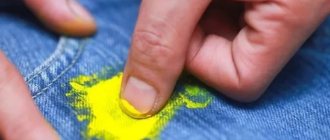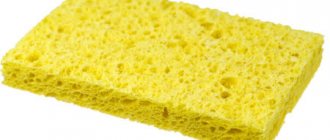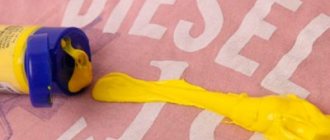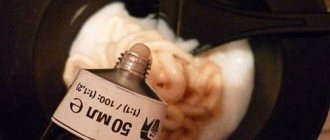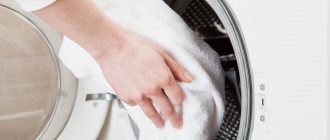Workers painting benches in cities do not always warn citizens not to sit on them. The consequence of such carelessness is paint stains from the painted bench on clothes.
You can wash them with various improvised and special means. But first you need to find out what kind of paint the item was damaged by.
In this article we will tell you how to remove paint from clothes from a painted bench (bench) at home.
Determining Process Complexity
It's easier to clean paint stains from clothes if you know the following:
- type of textile – natural, artificial;
- residence time of the mixture - fresh, old stain;
- type of coloring matter, durability.
Removing paint and varnish products requires experience, chemicals, and personal protective equipment. Dry cleaners that provide textile cleaning services have such materials. The main part of coloring substances can be eliminated at home, avoiding unnecessary expenses.
Mixtures that can be cleaned with improvised means:
- watercolor;
- gouache;
- enamel;
- oil;
- acrylic;
- latex;
- water-based.
Traditional methods
In some cases, it is not necessary to immediately use aggressive chemicals - you can solve the problem using folk recipes.
Gasoline and alcohol
Gasoline is good for removing stains from oil paints. You need to apply it to a cotton swab and rub the stain all around. After the procedure, the item is washed using powder or gel.
Attention! It is necessary to purchase only refined gasoline, which is sold in hardware stores. A regular product may stain clothing due to impurities in the composition.
Another effective remedy is a combination of laundry soap and alcohol. This recipe can be used against difficult stains on silk and satin. First, the blot is rubbed with soap, then the fabric is rinsed, and the contaminated area is treated with alcohol. Before this, the liquid must be heated in a water bath. After cleaning, you must hand wash the item in hot water.
Alcohol and salt help remove paint from both linen and nylon fabric. The blot needs to be rubbed with heated alcohol on the reverse side, then prepared with a saline solution and washed off any remaining dirt.
Hair fixation spray
Many hair styling products contain weak solvents. They do not harm human health, but help remove stains. Just spray the varnish and throw the item in the wash.
Salt and vinegar
To clean clothes from acrylic dye, you need to prepare a solution from the following ingredients:
- salt – 1 tbsp. l.;
- ammonia - 2 tbsp. l.;
- vinegar - 2 tbsp. l.;
- water – 750 ml.
The components need to be mixed and poured into the blot, leaving the product in the basin overnight. It is recommended to cover it so that the smell of ammonia does not spread to other rooms. The procedure is repeated until the dye completely disappears.
Acetone
Instead of acetone, nail liquid is suitable. First you need to soak a cotton swab in the solution, then start rubbing the stain from the edge to the middle. At the end of the procedure, the item is thrown into the machine.
Attention! Acetone is not used on delicate fabrics.
Turpentine
This product is suitable for removing stains from delicate materials such as silk, satin and wool.
First, apply a little turpentine to a cotton swab to treat the blot on the front and back of the fabric. After 10 minutes, cover the stain with paper towels on both sides and press together with your palms. There will be traces of paint on the paper that were removed by the product.
After this, the dirt is wiped off again with turpentine and left for 60 minutes, then the clothes are washed in the usual way in a machine or by hand.
Glass cleaner
To remove stains from clothes, just spray glass cleaner and rub it in for 2-3 minutes. After this, the dirt is rinsed off and the cleaning is repeated again. Paint stains are not a death sentence for things, since they can be removed with folk remedies and household chemicals. Before the procedure, you must wear protective gloves and follow safety precautions. If the fabric is expensive and requires special care, then it is recommended to take the clothes to the dry cleaner rather than clean them yourself.
Paint can easily get on things during creative activities, during repairs, or by pure accident. There is no point in throwing them away right away, because the stain can be removed. However, before you wipe the paint off your clothes, you should make sure that the products used are harmless.
Basic Rules
It is not recommended to treat textiles with chemical solvents on painted surfaces - the active substance will cause the top layer to peel off. The work area should be covered with film, white cotton cloth, and paper.
Acrylic, water-based, and oil paints should be removed from clothing in a well-ventilated area. Most solvents have a pungent odor that is unsafe for health, the inhalation of which leads to unpleasant consequences.
It is recommended to first test chemicals by applying a small amount to an inconspicuous area of the item. After checking, you can begin to treat the area where the mixture came into contact - you should act carefully, cleaning in the middle, avoiding spread. The end of the cleaning procedure should be accompanied by hand and machine washing and thorough drying.
Recommendations and prohibitions
When working with solvents, you must follow the advice and observe the prohibitions:
When processing an item, do not rub the product into it too much;- When cleaning, do not rub the stain from its center to the edges;
- do not wash the item after cleaning with a solvent in too hot water;
- Before using a solvent, test its effect on an inconspicuous area of the item.
Old stains should be soaked in alcohol before cleaning. Cloth with dried dirt can also be softened with butter.
Removing oil paint and enamel
Dyes of this type are quite durable, take a long time to wash, and require double or triple processing. Effective ways to remove fresh oil enamel:
- Lubricate the area with vegetable oil and wipe off with a cotton swab. Re-treat the remaining particles with oil, wash off with detergent after half an hour, securing the result by machine or hand washing.
- A concentrated solution of laundry soap can easily remove a fresh stain. Letting clothes sit for 15 minutes followed by washing will allow you to forget about contamination.
- A paste of baking soda and water, thoroughly rubbed into the stain, will help clean things. After 10 minutes, the textiles are rinsed by hand and thrown into the washing machine.
Attention. Chemicals should be used following safety rules, armed with rubber gloves and a respirator.
There are several ways to remove old paint from clothes:
- Kerosene, refined gasoline, white spirit. Algorithm of action: apply the selected substance, wait 15-20 minutes, remove the residue with laundry soap.
- A stain remover containing oxygen also dissolves dyes. It is enough to apply the liquid, then rinse the dirty item.
- An acetone-free nail polish remover mixed with warm glycerin works effectively.
How to remove paint from jeans using chemicals
Household chemicals can also help remove dye from jeans. First of all, you need to use dishwashing detergent, which is found in every home.
The algorithm of actions is as follows:
- Dish detergent is applied to the stain.
- Using a soft sponge, rub it into the fabric and leave for 24 hours.
- The stained area is thoroughly wiped with a brush.
- Jeans are rinsed well.
Bleach works well with unstable dyes and is suitable for cleaning white pants. The soiled item is soaked in bleach for 30-40 minutes, rinsed and placed in the washing machine. Bleach can be replaced with a solution of hydroperite, but it should be used carefully. You should first test hydroperite on a small piece of similar fabric.
You can remove dried paint from trousers or white jeans using chlorine. First, remove as much of the coloring pigment from the surface as possible with a stationery knife. Then place the item in a bleach solution of 5 liters of water and 1 liter of chlorine. Boil for 30 minutes, stir occasionally. The product is then placed in an automatic washing machine.
Among household detergents, tar soap can also help. It can even remove oil paints, as it perfectly dissolves the fatty substances on which these types of dyes are made. The contaminated area is rubbed with soap, before this it is slightly moistened and left for 2-2.5 hours. Wash jeans in the washing machine.
There are special stain removers on sale today designed for these purposes. They must be used strictly according to the instructions so as not to harm the material of the jeans.
Acrylic, water-based paint
Fresh stains can be easily washed off in warm soapy water. To make the procedure more effective, the dirt should be scrubbed with a stiff brush. Process thoroughly for 15-20 minutes.
Attention. Removing paint stains with stiff brushes is suitable for clothes made of thick fabric. It is recommended to clean natural, delicate textiles using more gentle methods.
A swab moistened with alcohol works well and should be used to wipe the stain until the traces disappear. 2 tablespoons of vinegar and salt dissolved in 2 glasses of water help quickly eliminate any remaining substances. The dried stain is pre-soaked, then the chosen stain removal method is used.
Latex paint
Contamination with dyes of this type can be removed by treating them with any product containing alcohol. For example, hairspray, acetone, alcohol. You can effectively remove dried colored mixture with adhesive tape - stick it to the contaminated area several times and peel it off.
Reference. Heat treatment of remaining tape leads to reprinting of the adhesive. This can be avoided by carefully removing any remaining adhesive tape.
A contaminated stain that has already dried should be soaked with alcohol, leaving the clothes on for a couple of minutes. The area where the paint hits is sprinkled with salt, then dipped into alcohol again. Carrying out the procedure several times will remove the oldest stains.
What kind of paint are used on outdoor benches?
Alkyd. This inexpensive type of paint belongs to the traditional materials that are most often used for painting wooden surfaces. The advantages of this type of coatings are abrasion resistance, glossy surface and minimal cost.
Interesting materials:
What is the cover for? Why is an intermediate relay needed? Why do you need to dry wood? Why do you need an RCD in electrical engineering? What are glue sticks used for? What are letter stamps used for? What are plastic granules used for? What are the figurines for? Why are three phases needed? Why are foundation mortgages needed?
Universal methods
How to remove paint from clothes from a bench, fence, or other objects where you can often get dirty? There are several universal methods for removing contaminants. Among them:
- Equal proportions of fatty kefir, vinegar, borax, thoroughly mixed, are applied to the outside and inside of the clothes. After drying, the dirt is cleaned with a toothbrush and washed off.
- Turpentine is an effective grease solvent. A cotton swab moistened with it wipes off almost any type of paint. If necessary, the processing procedure should be repeated.
- 1 tablespoon of salt, 2 each of ammonia and vinegar, mixed thoroughly, applied to the stain, after 10 minutes cleaned with a toothbrush, and washed.
- Light-colored clothes are cleaned by boiling. Chlorine is added to the water, proportion 1:6, heat treatment time 30 minutes.
Effective removal of fresh and old stains of colored mixtures requires careful preparation, knowledge of the matter, the ability to recognize the type of substance, textile, accuracy, and patience. Some stains are not immediately treatable and require longer or additional treatment. In general, removing paint stains is not difficult, following the recommendations given.
How to wash watercolor paints
Watercolor can be removed mechanically, using improvised means or stain removers.
Washing powder or laundry soap
It is better to wash watercolors immediately after getting on clothes. Before washing, it is soaked in cold water, stains are removed by hand with powder or soap, and bleach is applied to light-colored fabrics. After removal, normal washing is done.
Soap and soda
The method removes stains from light cotton and linen clothes. The item is first soaked in cold water and wrung out. 1 liter of water is poured into a metal basin, 1 tbsp is added. spoons of soda, 1/2 piece of laundry soap, grated on a coarse grater. Add a little bleach if desired. The mixture is placed on the stove and brought to a boil.
After boiling, wrung out clothes for 10-15 minutes. soaked in a soap-soda mixture, removed from it and soaked again. After the solution has cooled, wash the soiled item in it and then rinse it in clean water with conditioner.
Soap and denatured alcohol
The stained area is washed with soap and cool water. While the clothes are drying, a little technical ethyl alcohol is heated. Use a clean washcloth soaked in alcohol to wipe the stained areas on things until the stains disappear completely. Afterwards, the areas where the watercolor was are hand washed with warm water and then sent to the machine.
Ammonia and salt
Watercolor is removed from synthetic fabric. First, the stained area is wiped with a sponge soaked in ammonia. Then the clothes are soaked in a container with a cool saline solution, for the preparation of which 1-2 teaspoons are added to 1 liter of water. salt. After soaking, the item is washed with a suitable washing powder.
Soap and boiling water
Helps remove stains from woolen clothes. Things are soaked in cold water, then the stained area is rubbed with laundry soap. The soaped fabric is immersed in boiling water for a few seconds. After washing off the stain, the item is washed again.
Baby powder
The item is washed twice with high-quality baby powder.
If traces remain, the stain is washed off by hand with soap or the same powder.
Soda and peroxide
0.1 kg of soda and 0.1 liter of hydrogen peroxide are diluted in 0.1 liters of warm water. The resulting composition is used to treat the soiled part of the clothing, then wash it in the machine.
Vinegar
The method does not apply to delicate fabrics.
The vinegar heats up a little, and the area on the clothing with the paint that has fallen on it is treated. Afterwards, rinse in cool water and finally machine wash.
Stain removers
The product is selected according to the type of fabric of the clothing. Before using a stain remover, you should read its instructions.
Usually a little product is applied to the stain, after a few minutes it is washed off. If necessary, the procedure is repeated. At the end of cleaning, washing is done.
Popular stain removers:
- Vanish;
- Amway;
- Stork;
- soap with whitening effect “Eared Nannies”;
- Bos;
- Sarma;
- Domestos;
- Ecover;
- Antipyatin.
Mechanical removal
Using a dishwashing sponge or brush, you can remove watercolors mechanically only from dense materials. Dry paint is scraped off. Remains of watercolor will come out during washing.
Glycerol
The area is treated with a sponge generously soaked in glycerin. After 15-20 minutes. the paint softens and is easily removed from the fibers. Clothes are first washed in warm water and soap, and then as usual.
Glycerin and medical alcohol
Glycerin is mixed with ethanol in equal proportions and applied to the paint. After 15-20 minutes. Clothes are washed by hand with detergent, and finally washed in a machine.
Boiling
Dilute 1 tbsp in 1 liter of water. spoons of soap crumbs, ammonia, hydrogen peroxide and 20 g of soda ash. The clothes are soaked in the prepared mixture and boiled for at least half an hour over low heat. After boiling, the item is washed and rinsed in cool water with conditioner.


